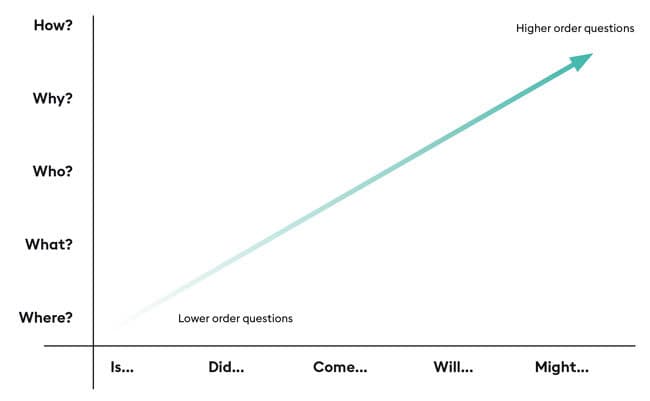How to generate higher order questions
There are many reasons we ask questions. As teachers, we ask questions to pique interest, review prior knowledge and check understanding, yet 4 per cent to 8 per cent of teacher questions being higher-order questions. Although full of questions, classrooms often lack higher-order student-based enquiry.
Encounter Edu Live Lessons provide a unique opportunity for students to indulge their curiosity and pick the brains of experts on a whole range of subjects. This can then give rise to discovery and learning you don’t come across every day.
To really get the most out of these Live Lessons, we have created a guide to support you and your students in selecting and developing higher-order questions, which spark engaging and informative discussions and encourage critical reflection.
Preparation
- Give students as much time as possible to think about their questions. This will involve planning and preparation ahead of time.
- Ensure students know the purpose of their questioning. Are they trying to gain factual information or find out someone’s opinion?
- Build on students’ prior knowledge and expertise. Do they have enough background information and experience? Ensure students have had enough exposure to the subject matter and relate it to their personal experiences.
- Promote wonderment, by ensuring students are free to wonder and not restricted by a requirement to investigate.
Generating questions
- Explain the difference between open and closed questions. Students will want to get as much air time for their questions as possible, so encourage them to construct open questions.
- Remind them that there’s no such thing as a silly question. Some of the most interesting discussions come from weird and wonderful questions that might have initially seemed silly. Our teams love answering these questions and they give rise to unique learning opportunities.
- Model higher-order questions.
- Don’t let students be put off by communication difficulties. These shouldn’t be a barrier to asking interesting and inquiring questions. You can scribe questions for them.
- Use visual aids such as mind mapping to organise questions into categories. Mind map all the questions on an interactive whiteboard and then ask students to identify questions that are asking the same thing. Move these questions together under a heading or category. They can then summarise the category into one or two higher-order questions.
- Question stems can help students formulate questions from an initial idea. Normally questions are higher-order as you move along these question words: What?, Where?, Who?, Why?, and How?; and then these verbs: Is…, Did…, Can…, Will…, and Might…

- This means that a question such as 'What is the deepest point in the ocean?' is considered a lower order question, compared to 'How might the deep ocean change in the future?'.
Refining questions
- Peer collaboration encourages discussion and reflection as well as critical and purposeful questioning.
- Deeper thinking, if the initial question posed is fairly low order, ask students to clarify what they mean and draw out deeper thinking; simply asking ‘What do you eat?’ can develop into ‘Are there foods you can’t get in the Arctic?’, ‘How do you store food and cook on the base?’ or ‘What food from home do you miss?’.
- Ask students to categorise or score their questions then select the best ones.
- By promoting ‘non-googleable questions’, students can use peer collaboration to develop a question. So, ‘How big is the biggest shark?’ becomes ‘What is the biggest shark you’ve seen and what happened?’.
- Follow general questions with a specific one ‘What’s the weather like there? What clothing is essential for working in that environment?’.
- Narrowing questions; ‘How is the Arctic affected by global warming?’ becomes ‘What effects of global warming have you witnessed? What do you think is causing this?’.
- To condense the questions further, students can vote for their favourite questions. Encourage blind voting or state that students can’t vote for their own question to encourage critical thinking and reflection.